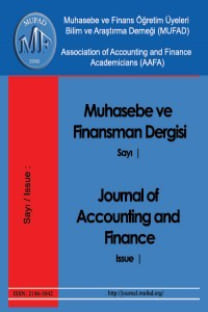Bilanço Ve Gelir Tablosu Bağıntıları Üzerine Bir Dinamik Tahlil Denemesi
Mali tablolar tahlili yarım yüzyıldır Türk üniversitelerinde muhasebe ders programlarında klasik bir yapıda yer almaktadır. Lisans üstü programlarda daha ileri seviyede tahlil çalısmaları yapılmakta ise de bu konuda fazla bir yayın yoktur. Bu incelemede yazarın lisans üstü ders programlarında denediği dinamik tahlil esasları ele alınmıstır. Kaynak- varlık gider-gelir dörtlüsü ve tek döneme ait bilanço ve gelir tablosu ele alınarak yapılan bu incelemelerde Muhasebe Sistemi Uygulama Genel Tebliği ( MSUGT) nde yer alan mali tablolar esas alınmıs ve bu tabloların mali tahlil esaslarına göre düzenlenmeleri üzerinde öncelikle durulmustur. Burada belirtmesi gerekmektedir ki, MSUGT’de yer alan dikey gelir tablosunun, dinamik tahlilin yapılabilmesi için gider ve gelir yanlarının ayrı ayrı ele alınarak çift yanlı kayıt yöntemi esaslarına göre düzenlenmesi uygun olabilecektir. Bu incelemede bir yandan bu tabloların tahlile hazır duruma getirilmeleri üzerinde durulurken, bir yandan da kaynak- varlık- gider- gelir bağıntıları üzerinde durulmustur. Bu bağıntılarda, is akısı, isletme çalısma döngüleri, amaçlar gibi kavramlar da ele alınmıstır. İncelemede, bilançonun varlık ve sermaye yanlarının tasnifi yapılırken değerlendirmeler yapılmıstır. Sonra da gelir tablosunun gider ve gelir yanlarının tasnifi yapılırken değerlendirmeler de yapılmıstır. Ve yer yer dörtlü bağıntılar ele alınarak incelemelerde bulunulmustur.
Anahtar Kelimeler:
Mali tablolar, mali tablolar tahlili, dinamik tahlil.
A Dynamic Analysis Experiment About The Correlations Of The Balance Sheet And The Income Statement
Financial statements analysis has been in the accounting curriculum of Turkish universities in a traditional sense for half a century. There are not many publications on this subject although there are advanced analysis studies in the master’s degrees. This paper examines the author’s dynamic financial analysis principles which were executed in his financial statements analysis master’s degree courses. Balance Sheet, Income Statement and sourceasset-expense-income quad were taken into consideration in the paper. Thus, the financial statements of the Turkish Uniform Accounting System and the relevant principles constitute the basis of the paper. It is crucial to mention that the expense and the income parts of the vertical income statement were used separately and prepared for the principles of the double entry accounting system in order to establish a dynamic analysis. The paper focuses on the preparation of financial statements as well as the source-asset-expense-income correlations. Concepts like workflow, business cycles, and goals were taken into consideration within the mentioned correlations. The asset and the capital parts of the balance sheet were classified and evaluated in the paper. Also, the expense and the income parts of the income statement were classified and evaluated. Quad correlations were also taken into consideration in the reviews
- ISSN: 2146-3042
- Yayın Aralığı: Yılda 4 Sayı
- Başlangıç: 2005
- Yayıncı: Muhasebe ve Finansman Öğretim Üyeleri Derneği (MUFAD)
Sayıdaki Diğer Makaleler
Zaman Sürücülü Faaliyet Tabanlı Maliyetlemenin Bir Sanayi İsletmesinde Uygulanması
Hayrettin Usul, İsmet Titiz, Burcu A.Ateş
Türkiye’de Meslek Yüksekokullarının Bölge İhtiyaçlarına Uygunluğu Üzerine Bir Araştırma
Gülsün İşseveroğlu, Ümit Gücenme Gençoğlu
Muhasebe Bilgi Kalitesini Etkileyen Kritik Başarı Faktörleri
Bilanço Ve Gelir Tablosu Bağıntıları Üzerine Bir Dinamik Tahlil Denemesi
İMKB Sirketleri için Yeni Olanak: Hisse Senedi Geri Satın Alımı
